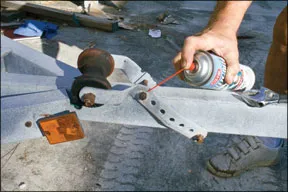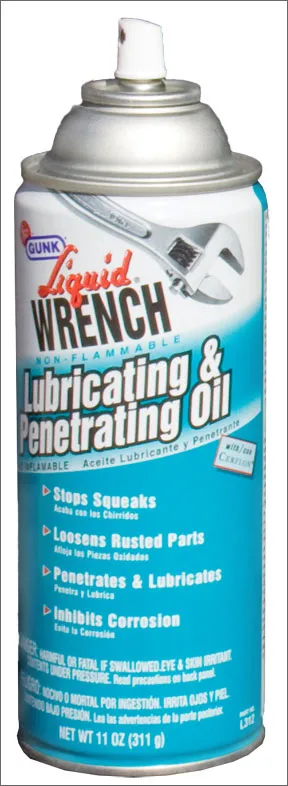For those of us living, working, and playing on the water, rust can show up all too often, as the trailer for one of Practical Sailors test boats recently reminded us. Testers tried four aerosol products marketed as penetrating oils-WD-40, Liquid Wrench, PB Blaster, and CRC Freeze-Off-on the rusted U-bolts, and seized nuts and bolts of the neglected trailer to determine which is the best rust buster.
****
Rust. It can spoil your day.

When it builds up between two metal parts that are supposed to move, it can really be a project-stopping pain. For those of us living, working, and playing near water, it shows up all too often.
Rust consists of oxides of iron or steel formed by the action of moisture and oxygen on the metal surface. Salt water, spray, and air add an electro-chemical reaction that can lower the PH and speed up the process.
Using quality stainless-steel hardware and proper maintenance on board should prevent major incidents or inconvenience. However, when left unattended in moist conditions, metal parts on older vessels, machinery, and trailers inevitably will lock up with rust.
There are many products on the market claiming to be “rust removers” or “rust dissolvers.” Most contain acids of some type, are messy to apply, and are not recommended for use on fiberglass boats. (Well look at these in a future article.)
Tests that involve rusty bits are not an exact science, primarily because rusted parts are like snowflakes: No two are alike. The chemistry can get complicated, and empirical tests tend to be inconclusive. We tried anyway.
Practical Sailor had an immediate need for rust busters when we were refurbishing an old trailer for our ODay Javelin test boat, Misty. Most of the U-bolts and nuts and bolts holding the pads were in various stages of corrosion. So we attacked the seized hardware with several penetrating sprays, and a test ensued.

What We Tested
We acquired four aerosol products marketed as penetrating oils that would loosen rusted bolts: WD-40 from the WD-40 Co., Liquid Wrench from Radiator Specialty Co., PB Blaster from the Blaster Corp., and Freeze-Off from CRC Industries.
The products are well known, and the sprays are readily available at local hardware and marine supply stores and online. The sprays have five basic functions:
Penetrate deep between two metal parts by capillary effect.
Provide a solvent to dissolve or affect corrosion and rust.
Displace or dry out moisture.
Provide a lubricant to ease friction of moving parts.
Provide a film coating for long-term protection.
All four tested sprays provided at least three-and sometimes four-of these functions with varying effectiveness. We found that all were good products for what they do.
How We Tested
We applied a different spray on the bolts in each quadrant of Mistys trailer and noted the ease of loosening and removing the rusted nuts. Manufacturer directions were followed. Light tapping with a hammer was applied to loosen the rust. Wrenches and even a pipe extension were sometimes needed to apply pressure.

In a separate test, we applied Freeze-Off and PB Blaster to an abandoned pump and machinery left outside for several years.
WD-40
Originally released in 1953, so the story goes, it was the companys 40th attempt to formulate a workable “Water Displacement” formula that was successful, and the name stuck. WD-40 is a petroleum product designed to displace moisture, penetrate between surfaces, provide lubricant, and leave a thin, oily film for protection.
The newer WD-40 cans have a “Smart Straw,” a unique, foldable straw permanently attached. Considering the number of red straws weve lost overboard or into the dark recesses of cockpit lockers, testers found the fixed applicator a “smart” innovation indeed.
Bottom line: Tests found WD-40 to be best at displacing moisture, providing light lubricant and a thin film for protection, but its solvents were not as effective as others.
Liquid Wrench
Another trusted name in penetrating oils, the petroleum Liquid Wrench was designed to have a capillary effect to penetrate and lubricate in hard-to-get-to places and will loosen some rusted parts. It does not dissolve rust but supplies lubricant and a graphite base to reduce friction, protect metal, and inhibit corrosion. Application requires a red straw that comes taped to the can.

Bottom line: Liquid Wrench does a better job than WD-40 of penetrating, and also provides lubricant and a graphite protectant.
PB Blaster
Another old and venerated product, PB Blaster has been around for over 50 years. It is a concentrated copolymer petroleum product with a catalyst that has a unique foaming capillary action.
Its deep penetration qualities are well documented. It has the ability to stick to metal and work its way uphill, breaking surface tension caused by rust and corrosion. Like the others, it includes a lubricant and comes with a red straw applicator.
Bottom line: PB Blaster has a strong solvent and deep chemical and capillary penetrating effect. It also contains several lubricants and leaves a thin, oily protective film. It did the best job of loosening the rusted bolts on our trailer, and so takes the top spot for this usage.
CRC Freeze-Off
Less than two years old, CRCs Freeze-Off is not a petroleum oil lubricant, but is specifically designed to loosen rust-bonded metals. Almost half of the formula is the propellant HFC152A, which when exposed to air, immediately drops the temperature of what it touches about 60 to 70 degrees. The formula also includes special penetrating solvents.
The idea is to spray the affected rusted parts for about 10 seconds to cause a sudden drop in temperature that contracts the metal. This should open cracks and fissures in the rust, allowing the solvents to penetrate deep between the metal parts to dissolve more rust. The company claims the formula will not harm fiberglass or plastics, but caution should be taken when using around rubber gaskets.

Bottom line: Freeze-Off has the unique ability, under the right conditions, to contract metal parts so that their solvent can penetrate deeper. It has limited lubricant and protective properties.
What We Found
The bolts sprayed with just WD-40 were the hardest to break free. Testers were a little more successful with Liquid Wrench.
The Freeze-Off and PB Blaster applications worked even better. Both of their solvents seemed to have good penetrating power. However, the lower temperature of the Freeze-Off just didnt seem to make a difference. Multiple applications seemed to help, but in the end, the yellow foaming PB Blaster dissolved and loosened more rust.
Conclusion
Practical Sailor talked to three mechanics in metal shops that deal with rust in cars, truck, and trailers. They all reported using PB Blaster to loosen frozen bolts, but admitted applying heat and several good wumps with a hammer to the stubborn ones.
There will be situations when a torch and wumps can’t be used. Thats when Freeze-Offs concentrated spray and cooling effect to break free a rusted part will be a better choice, especially near fiberglass and plastic.
Depending on the job at hand, all these sprays will work. But the top performer at curing our frozen bolts was PB Blaster.




































A friend of mine bought a preowned outboard Mercury motor that had been used in salt water. The tiller hinge is frozen and the motor cannot be turned in either direction. Several chemical products have been tried none have proven successful. There is limited access to the internal hinge to apply pressure . He has not tried the CRC freeze off product but I would welcome any assistance you can offer.
Thank You
Don’t forget to be patient. Spray some on thump it go have lunch or sleep. Then try torch and repeat. 1″ ss pipe makes a great beaker bar if you have access.